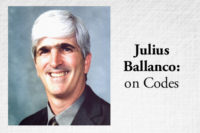The ICC’s Annual Conference Sept. 27-Oct. 5 in Long Beach, Calif., was promised to be the start of a new era of electronic voting.
The membership in attendence would vote electronically following the testimony. That vote total would be announced with members not in attendance allowed to vote electronically over a two-week period following the event.
Everything seemed to be going well until the vote totals began to look off. One vote had around 80 people casting their ballot, then 15 minutes later just 16 votes were counted. A plausible explanation could be that the members just weren’t interested in the code change and decided not to vote.
It wasn’t until two days later when the votes really seemed inaccurate that a member went to the microphone and asked that the voting devices be checked for accuracy. One of the reasons for the request is a number of inspectors indicated their vote didn’t seem to register on the device.
After a break to set up the test, a hand count of voting members was conducted followed by the same members activating their voting devices. The numbers didn’t match up.
So, after checking for possible technical difficulties, the vote was taken again. The second test also was a failure. ICC announced it would end the hearings early (even though there was 90 minutes left until quitting time) so it could check the voting system that evening.
The following morning members were asked to test their tools again. While ICC staff was confident the system would check out fine, the test was a failure. Then a second test was conducted. Again, a failure.
Abandon ship
This is when ICC abandoned the voting devices and converted to a hand vote. Interestingly, there is nothing in the ICC procedures that allows for a hand vote at the conference. All voting is supposed to be electronic. Of course, the failure of the multiple tests calls into question all the votes taken over the previous three days.
ICC staff and various board members huddled to figure out what to do. Any vote taken electronically can easily be questioned. As of the date of this writing in early October, no decision had been made as to what to do with the first three days of voting.
While most ballots can be recovered by electronic voting during the two-week period of online voting, the real problem is with the public comments proposing a modification. If the modification does not receive a two-thirds affirmative vote at the annual conference hearings, it can’t move forward to electronic voting. The proposed modification simply dies.
In fairness to the system, ICC is going to have to figure out how to allow remote voting on the modifications that were electronically voted on. Otherwise, the groups may have a mess of challenges or lawsuits on their hands.
It was my intention to write about the crazy voting habits of the members, but that may not have happened. On the first day there were many votes to uphold the committee’s decision. In some cases, nobody spoke against a change. Former opponents even spoke in support of certain changes, yet the vote was to support the committee’s recommendation.
Some of the changes that received overwhelming support dealt with the modification to the fixture table. As I previously reported, there were changes to allow single- occupant toilet rooms rather than gang toilet rooms. For example, the change would allow 10 separate toilet rooms rather than five water closets in the men’s room and five in the ladies’ room. That change was approved at the hearing and now awaits the electronic vote of the membership.
Drink up
Other changes would allow the number of drinking fountains to be reduced and the number of service sinks reduced. Both changes received more than the required two-thirds positive vote.
When the ASPE change on potty parity came up, most thought it would receive similar support following the other changes. However, the membership clearly indicated it is not concerned with potty parity when an architect adds more than the required number of fixtures to the men’s room. The change failed to even receive a majority vote.
All of the proposed changes on water conservation were recommended for disapproval. The PERC 2 report had been issued two days prior to the code hearing and a few people managed to attempt to quote from the study.
It was interesting to note the comments on PERC 2 were wrong based on the proposed changes. PERC 2 recommendations were for water closets with a flush volume that was lower than the proposed flush volumes in the proposed changes.
As the plumbing changes got more technical, so did the testimony. However, that also seemed to signal to the members that the committee’s position should be supported. For most technical changes, the membership appeared to uphold the committee’s recommendation – assuming the electronic devices were properly working.
There was a lot of discussion on Legionella and both the ICC’s Plumbing Code and Mechanical Code proposed changes to require the water piping systems to comply with ASHRAE 188 – the new standard on Legionellosis risk management.
There were a number of people who spoke in opposition to the acceptance of the standard. It was identified as a risk management standard and not a design standard. ASHRAE countered, stating there are design requirements in the standard. However, with that much opposition it is rare to see a positive vote. All the changes on Legionella were denied by large margins. It seemed to indicate any change this technical first needs the support of the code-change committee.
When food-waste disposers were discussed, there was a small contingent of anti-disposer people present. During testimony, you would think food-waste disposers were the worst devices ever invented. However, it was pointed out the code change had nothing to do with banning food-waste disposers.
The one change that received overwhelming support was the proposal to prohibit food-waste disposers from discharging through a grease interceptor. The testimony was so technical that days later individuals in the audience still were talking about the amount of grease in human waste. Of course, they were chuckling about how detailed the discussion was.
You can review all the results of the hearings on the ICC website for code activities at www.cdpaccess.com. You also can click on a code change and watch the testimony on any of the proposed changes. I would encourage you to watch some of the testimony just so you have an idea of how the codes regulating your profession are developed.
Enjoy the viewing.



